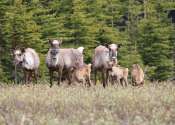many, see text
The reindeer (Rangifer tarandus), also known as the caribou in North America, is a deer from the Arctic and Subarctic, including both resident and migratory populations. While overall widespread and numerous, some of its subspecies are rare and one (or two, depending on taxonomy) has already gone extinct.
Reindeer vary considerably in color and size. Both sexes grow antlers, though they are typically larger in males. There are a few populations where females lack antlers completely.
Wild reindeer hunting and herding of semi-domesticated reindeer (for meat, hides, antlers, milk and transportation) is important to several Arctic and Subarctic people. Even far outside its range, the reindeer is well known due to the myth, probably originating in early 19th century America, in which Santa Claus's sleigh is pulled by flying reindeer, a popular secular element of Christmas. In Lapland, reindeer pull pulks.









